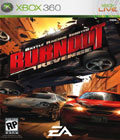Genre: Racing
Publisher: Electronic Arts
Developer: Criterion
Release Date: September 13, 2005
Criterion's Burnout series has been tearing up the video game charts as one of the best-selling and most popular racing titles out there, and for good reason. The first two games in the series really showed a lot of promise and were great games in their own right, but things didn't really come together until Burnout 3: Takedown. The game really set a new standard in gameplay, not solely for racing titles, but for all games, period.
The core gameplay we know and love in Burnout 3 is back again in Burnout Revenge, and it is mostly unchanged, but the developers did have to tweak a few key areas, one of which was the level design. In Burnout 3, the game really focused on car-to-car battles, and while the tracks were great, they were mainly designed for this type of gameplay, offering many narrow sections of track where you could easily rub fenders with your opponents.
In Revenge, the main focus is still on car-to-car interactions, but it has shifted to also include a heavy emphasis on the track itself. The tracks in Revenge offer a good mixture of both narrow and wide open sections, but one of the series' new features is the inclusion of different paths and shortcuts. The best way to describe it is Burnout 3 meets San Francisco Rush. The tracks themselves have been designed as battlegrounds on which you and other cars may fight. Each track offers many different paths and shortcuts, and some of these paths have massive ramps that you can hit to gain access to new sections of the level, or use to launch yourself into opponents' cars.
Aside from the different paths, the levels are now full of objects, such as parked cars, support beams, trash dumpsters and raised sections of road into – or off of – which you can knock unfortunate opponents for some spectacular crashes. This really gives the game even more depth, as you aren't simply racing on a track but also looking for shortcuts and different things to use to your advantage.
Another new addition to the series is the ability to ram traffic from behind and use them like missiles, hitting them into your opponents. This only works for traffic that is going in the same direction as you though, as on-coming traffic still kills you instantly! It definitely takes some practice, but once mastered it can be a deadly tool, not to mention a very satisfying way to take out your opponents.
The coolest new feature was the ability to use the Crashbreaker in the standard race modes. For those of you who missed Burnout 3, the Crashbreaker is a feature that was only usable in the Crash race mode, which allowed you to make your car explode after a certain number of vehicles were wrecked in your crash. Any time you get into a wreck in the standard race mode of Burnout Revenge, you have the option to use a Crashbreaker.
There is a catch, though, to help keep things nice and balanced: the amount of boost you have when you get into the wreck determines how much damage your Crashbreaker will cause. Additionally, if you use the Crashbreaker and fail to take out any opponents, you lose all of your boost. Aside from causing your car to blow up in a massive fireball, any vehicles going by when you set off your Crashbreaker will also explode, which will, in turn, set off even more blasts, thereby creating a massive chain reaction. When I first saw this feature, I thought that it might make taking out opponents too easy, but that's really not the case because Criterion did a great job of balancing it.
Graphically speaking, Burnout Revenge looks pretty much the same as Burnout 3, which is not a bad thing by any means, since it was quite stunning. The explosions look a little bit better, as do some of the other effects, and while the graphics themselves haven't changed too much, the amount of detail in the tracks has increased quite a bit. These little details really make the cities feel alive and give you the sense that you aren't just racing on a track, but are part of a living, breathing world.
Overall, I really walked away impressed with what I saw in Burnout Revenge. Some will no doubt argue that the game does not play that differently from Burnout 3, which is actually true, but considering just how good the third iteration was, Criterion really didn't need to change much. They could have just released the same game with new cars, tracks and missions, but instead, they took the time to add lots of new features. While none of them change the core gameplay all that much, they help to make Burnout Revenge more fun and refined.
More articles about Burnout Revenge











 Burnout Revenge lets gamers rip through rush hour traffic and lay waste to scores of rubbernecking roadhogs in an over-the-top scene of vehicular mayhem. In addition to tricked out new race, crash and road rage modes, Burnout Revenge takes the series' blistering speed and spectacular destruction to dizzying new heights with an all-new Revenge mode, challenging gamers to battle the clock and unleash their frustrations on rush hour traffic.
Burnout Revenge lets gamers rip through rush hour traffic and lay waste to scores of rubbernecking roadhogs in an over-the-top scene of vehicular mayhem. In addition to tricked out new race, crash and road rage modes, Burnout Revenge takes the series' blistering speed and spectacular destruction to dizzying new heights with an all-new Revenge mode, challenging gamers to battle the clock and unleash their frustrations on rush hour traffic.










